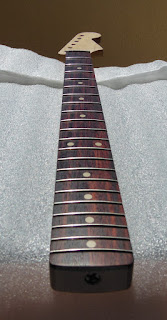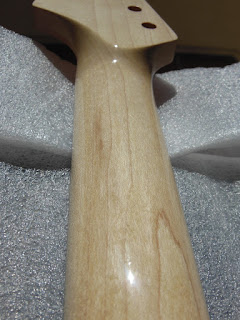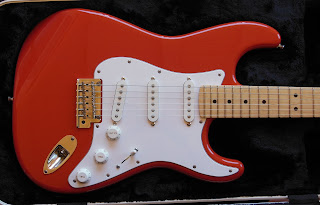I've decided that it's time to build a new Strat.
The Fiesta Red one has been serving me quite well for the past two years, and it was a very nice mix of modern American Standard Strat specs along with some more vintage-y things on it. However, I've always been drawn to the idea of building something a bit closer to a 60s style vintage Strat, and this project will fill that purpose.
This particular build is going to follow the specs of a 1962 Stratocaster with an Olympic White body and slab rosewood fingerboard. I've decided to go all Warmoth this time (as opposed to an Allparts body like I did last time) due to finding a good price, a good weight (body is 4 lbs exactly), and the smaller chance that I'll have to do any neck pocket sanding (like on the Fiesta Red Strat) since both parts come from the same maker. I've got to say the paint job is superb on the Warmoth body (just around the same quality as the Allparts one) and there's not much difference in quality between the two, so it just comes down to a matter of preference.
Body specs:
- Warmoth vintage Stratocaster body.
- Olympic White finish.
- 4.0 lbs.
The Olympic White finish is just a slight off-white that's very pleasing, especially in the sunlight:
The neck pocket is very clean and I probably won't need to do any sanding here:
The routed cavities are at the vintage depth of 5/8" as opposed to 3/4" for modern American Standard Strats. Warmoth has an option for ordering a modern Strat style body or a vintage Strat style body. The differences are in the deeper contours and the shallower routs of the vintage. The Allparts body on the Fiesta Red has the same deep contours but splits the difference in the rout depth, as it was right in between 5/8" and 3/4" when I was building the Fiesta Red Strat.
I intend on putting some Dimarzio Areas in this guitar (since I loved the Dimarzio Area 58, 67, 61 set that I put in the other one), and I'm hoping there's enough depth due to the Area pickups being stacked coils and therefore slightly taller than vintage pickups. We'll see what happens!
Neck specs:
- Warmoth total vintage construction (truss rod adjustment is at the heel of the neck rather than the headstock). The truss rod setup will make it slightly harder to adjust since the neck must be removed from the body before it can be touched. This is in contrast to the Fiesta Red Strat which has the truss rod adjustment near the headstock. However, that neck turned out to require no adjustment at all, and I'm hoping for the same case here.
- Slab rosewood fingerboard on maple neck. Slab fingerboards were introduced to the Strat in 1959 and gave way to the veneer fingerboard roughly in 1963. The difference is that the slab is cut flat where it's glued to the maple neck, whereas the veneer's bottom is curved along with the curvature of the fingerboard radius. Not many aftermarket neck makers actually do veneer fingerboards, but luckily I'm doing this with 1962 specs in mind.
- Vintage nut width: 1-5/8" (compared to American Standard 1-11/16").
- Skinny and tall frets (6105). Not vintage (shallow) because I want just a bit more life out of these frets. I would have been OK with 6150s (medium jumbo), but this neck was on sale and happened to have 6105s, so I'm happy.
- Vintage 7.25" fretboard radius (compared to American Standard 9.5"). This is rounder and easier for stuff like barre chords, harder to bend without choking the note. Compromises, compromises.
- Vintage number of frets (21, compared to American Standard 22).
- Standard thin C neck back profile.
I love the contrast between the dark rosewood and the light maple underneath:
The truss rod adjustment nut is clearly visible at the neck's heel:
No truss rod hole at the headstock:
This is Indian rosewood (not Brazilian, obviously), but still very beautiful and has a very interesting grain pattern:
Since this is a vintage style 2-piece neck, the truss rod is inserted underneath the rosewood fingerboard. No truss rod hole at the headstock and no walnut skunk stripe at the back (as there is one for 1-piece maple necks due to the need for routing a channel for the rod without the access via fingerboard):
I love the clear finish. Really brings out the best of the wood grain:
Next steps are to order some tuners (preferably Gotoh vintage locking), vintage trem unit, and then start thinking about other hardware parts. I'm thinking of ordering a mint green 60s style pickguard with the truss rod notch (a little notch cut in the pickguard to give slightly more access to the truss rod at the neck heel), and probably white hardware (as opposed to aged white), but we'll see. I'm taking this project nice and slow to think about all the possibilities and all the things that may change.












































































